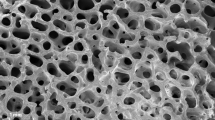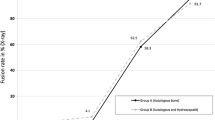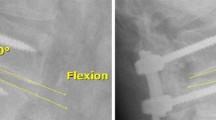Abstract
The current gold standard in lumbar fusion consists of transpedicular fixation in combination with an interbody interponate of autologous bone from iliac crest. Because of the limited availability of autologous bone as well as the still relevant donor site morbidity after iliac crest grafting the need exists for alternative grafts with a comparable outcome. Forty patients with degenerative spinal disease were treated with a monosegmental spondylodesis (ventrally, 1 PEEK-cage; dorsally, a screw and rod system), and randomly placed in two groups. In group 1, autogenous iliac crest cancellous bone was used as a cage filling. In group 2 the cages were filled with an allogenic cancellous bone graft. Following 3, 6, 9 and 12 months, the clinical outcome was determined on the basis of: the Oswestry Low Back Pain Disability Questionnaire; patient satisfaction; patient willingness to undergo the operation again; and a visual analog scale for pain. The radiological outcome was based on both fusion rate (radiographs, computed tomography), and on the bone mineral density of the grafts. After 6 months, the X-rays of the patients in group 2 had a significantly lower rate of fusion. Aside from this, there were no further significant differences. After 12 months, radiological results showed a similar fusion rate in both groups. Donor site complications consisted of five patients with hematoma, and three patients with persistent pain in group 1. No implant complications were observed. If a bone bank is available for support and accepting the low risk of possible transmission of infectious diseases, freeze–dried allogenic cancellous bone can be used for monosegmental spondylodeses. The results demonstrated an equivalent clinical outcome, as well as similar fusion rates following a 12-month period. This is in despite of a delayed consolidation process.





Similar content being viewed by others
References
Arrington ED, Smith WJ, Chambers HG, Bucknell AL, Davino NA (1996) Complications of iliac crest bone graft harvesting. Clin Orthop Relat Res 300–309. doi:10.1097/00003086-199608000-00037
Boden SD (2002) Overview of the biology of lumbar spine fusion and principles for selecting a bone graft substitute. Spine 27:S26–S31. doi:10.1097/00007632-200208151-00007
Boden SD, Schimandle JH (1995) Biologic enhancement of spinal fusion. Spine 20:113S–123S. doi:10.1097/00007632-199512151-00007
Brantigan JW, McAfee PC, Cunningham BW, Wang H, Orbegoso CM (1994) Interbody lumbar fusion using a carbon fiber cage implant versus allograft bone An investigational study in the Spanish goat. Spine 19:1437–1444
Brantigan JW, Steffee AD (1993) A carbon fiber implant to aid interbody lumbar fusion. Two-year clinical results in the first 26 patients. Spine 18:2106–2107
Brantigan JW, Steffee AD, Geiger JM (1991) A carbon fiber implant to aid interbody lumbar fusion mechanical testing. Spine 16:S277–S282. doi:10.1097/00007632-199106001-00020
Brodsky AE, Kovalsky ES, Khalil MA (1991) Correlation of radiologic assessment of lumbar spine fusions with surgical exploration. Spine 16:S261–S265. doi:10.1097/00007632-199106001-00017
Buck BE, Malinin TI, Brown MD (1989) Bone transplantation and human immunodeficiency virus. An estimate of risk of acquired immunodeficiency syndrome (AIDS). Clin Orthop Relat Res 240:129–136
Buttermann GR, Glazer PA, Bradford DS (1996) The use of bone allografts in the spine. Clin Orthop Relat Res 75–85. doi:10.1097/00003086-199603000-00010
Dawson EG, Clader TJ, Bassett LW (1985) A comparison of different methods used to diagnose pseudarthrosis following posterior spinal fusion for scoliosis. J Bone Joint Surg Am 67:1153–1159
Deyo RA, Nachemson A, Mirza SK (2004) Spinal-fusion surgery—the case for restraint. N Engl J Med 350:722–726. doi:10.1056/NEJMsb031771
Fairbank JC, Couper J, Davies JB, O’Brien JP (1980) The Oswestry Low Back Pain Disability Questionnaire. Physiotherapy 66:271–273
Fernyhough JC, Schimandle JJ, Weigel MC, Edwards CC, Levine AM (1992) Chronic donor site pain complicating bone graft harvesting from the posterior iliac crest for spinal fusion. Spine 17:1474–1480
Gerbershagen HU, Lindena G, Korb J, Kramer S (2002) Health-related quality of life in patients with chronic pain. Schmerz 16:271–284. doi:10.1007/s00482-002-0164-z
Glassman S, Gornet MF, Branch C, Polly D Jr, Peloza J, Schwender JD, Carreon L (2006) MOS short form 37 and Oswestry Disability Index outcomes in lumbar fusion: a multicenter experience. Spine J 6:21–26. doi:10.1016/j.spinee.2005.09.004
Hahnel H, Muschik M, Zippel H, Gutsche H (1991) Lumbar segmental spondylodesis-isolated ventral or combined dorsoventral? A comparison of results. Z Orthop Ihre Grenzgeb 129:197–203
Hutter CG (1983) Posterior intervertebral body fusion. A 25-year study. Clin Orthop Relat Res 179:86–96
Janssen ME, Nguyen C, Beckham R, Larson A (2000) Biological cages. Eur Spine J 9(Suppl 1):S102–S109. doi:10.1007/PL00008315
Katz JN (1995) Lumbar spinal fusion Surgical rates, costs, and complications. Spine 20:78S–83S. doi:10.1097/00007632-199512151-00002
Kozak JA, Heilman AE, O’Brien JP (1994) Anterior lumbar fusion options. Technique and graft materials. Clin Orthop Relat Res 300:45–51
Lund T, Oxland TR, Jost B, Cripton P, Grassmann S, Etter C, Nolte LP (1998) Interbody cage stabilisation in the lumbar spine: biomechanical evaluation of cage design, posterior instrumentation and bone density. J Bone Joint Surg Br 80:351–359. doi:10.1302/0301-620X.80B2.7693
Malanin TI (1992) Bone Grafts and Bone Substitutes. In: Habal MB, Reddi AH (eds) Acquisition and banking of bone allografts. WB Saunders, Philadelphia
Marchesi DG (2000) Spinal fusions: bone and bone substitutes. Eur Spine J 9:372–378. doi:10.1007/s005860000203
McAfee PC, Boden SD, Brantigan JW, Fraser RD, Kuslich SD, Oxland TR, Panjabi MM, Ray CD, Zdeblick TA (2001) Symposium: a critical discrepancy-a criteria of successful arthrodesis following interbody spinal fusions. Spine 26:320–334. doi:10.1097/00007632-200102010-00020
Modic MT, Masaryk TJ, Ross JS, Carter JR (1988) Imaging of degenerative disk disease. Radiology 168:177–186
Muschler G, Lane J, Dawson E (1990) The biology of spinal fusion. In: Cotler J, Cotler H (eds) Spinal fusion, science and technique. Springer, Heidelberg
Niemeyer T, Bovingloh AS, Halm H, Liljenqvist U (2004) Results after anterior-posterior lumbar spinal fusion: 2–5 years follow-up. Int Orthop 28:298–302. doi:10.1007/s00264-004-0577-7
Pavlov PW, Meijers H, van Limbeek J, Jacobs WC, Lemmens JA, Obradov-Rajic M, de Kleuver M (2004) Good outcome and restoration of lordosis after anterior lumbar interbody fusion with additional posterior fixation. Spine 29:1893–1899. doi:10.1097/01.brs.0000137067.68630.70 (discussion 1900)
Pelker RR, Friedlaender GE (1987) Biomechanical aspects of bone autografts and allografts. Orthop Clin North Am 18:235–239
Pruss A, Baumann B, Seibold M, Kao M, Tintelnot K, von Versen R, Radtke H, Dörner T, Pauli G, Göbel UB (2001) Validation of the sterilization procedure of allogeneic avital bone transplants using peracetic acid-ethanol. Biologicals 29:59–66. doi:10.1006/biol.2001.0286
Putzier M, Funk JF, Schneider SV, Gross C, Tohtz SW, Khodadadyan-Klostermann C, Perka C, Kandziora F (2006) Charite total disc replacement–clinical and radiographical results after an average follow-up of 17 years. Eur Spine J 15:183–195. doi:10.1007/s00586-005-1022-3
Ray CD (1997) Threaded titanium cages for lumbar interbody fusions. Spine 22:667–679. doi:10.1097/00007632-199703150-00019 (discussion 679-680)
Santos ER, Goss DG, Morcom RK, Fraser RD (2003) Radiologic assessment of interbody fusion using carbon fiber cages. Spine 28:997–1001. doi:10.1097/00007632-200305150-00007
Simmons JW (1985) Posterior lumbar interbody fusion with posterior elements as chip grafts. Clin Orthop Relat Res 193:85–89
Videbaek TS, Christensen FB, Soegaard R, Hansen ES, Hoy K, Helmig P, Niedermann B, Eiskjoer SP, Bunger CE (2006) Circumferential fusion improves outcome in comparison with instrumented posterolateral fusion: long-term results of a randomized clinical trial. Spine 31:2875–2880. doi:10.1097/01.brs.0000247793.99827.b7
Williams AL, Gornet MF, Burkus JK (2005) CT evaluation of lumbar interbody fusion: current concepts. AJNR Am J Neuroradiol 26:2057–2066
Wimmer C, Krismer M, Gluch H, Ogon M, Stockl B (1999) Autogenic versus allogenic bone grafts in anterior lumbar interbody fusion. Clin Orthop Relat Res 122–126. doi:10.1097/00003086-199903000-00015
Xue Q, Li H, Zou X, Bunger M, Egund N, Lind M, Christensen FB, Bunger C (2005) Healing properties of allograft from alendronate-treated animal in lumbar spine interbody cage fusion. Eur Spine J 14:222–226. doi:10.1007/s00586-004-0771-8
Zdeblick TA, Ducker TB (1991) The use of freeze–dried allograft bone for anterior cervical fusions. Spine 16:726–729. doi:10.1097/00007632-199107000-00006
Zelle B, Konig F, Enderle A, Bertagnoli R, Dorner J (2002) Circumferential fusion of the lumbar and lumbosacral spine using a carbon fiber ALIF cage implant versus autogenous bone graft: a comparative study. J Spinal Disord Tech 15:376–379
Author information
Authors and Affiliations
Corresponding author
Rights and permissions
About this article
Cite this article
Putzier, M., Strube, P., Funk, J.F. et al. Allogenic versus autologous cancellous bone in lumbar segmental spondylodesis: a randomized prospective study. Eur Spine J 18, 687–695 (2009). https://doi.org/10.1007/s00586-008-0875-7
Received:
Revised:
Accepted:
Published:
Issue Date:
DOI: https://doi.org/10.1007/s00586-008-0875-7




